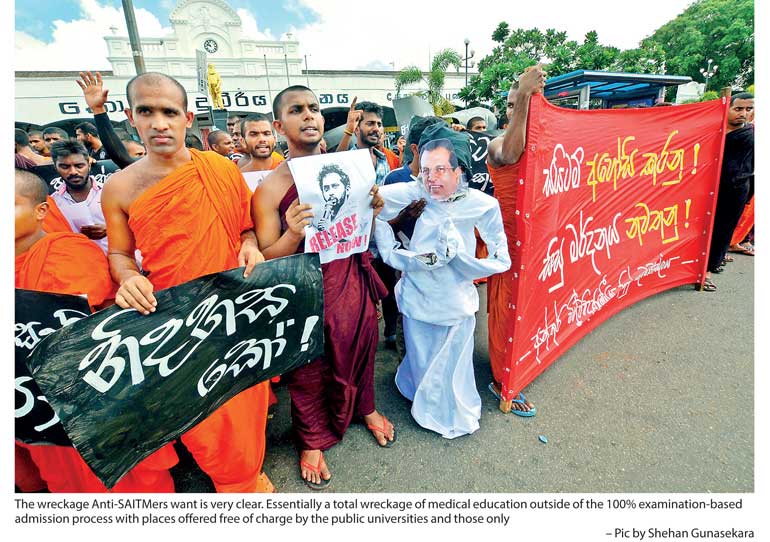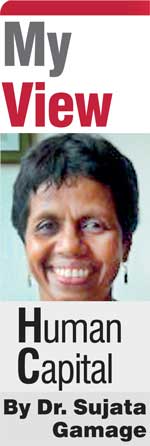Enough piecemeal solutions: A coherent HR policy for the health sector is needed
 Friday, 2 February 2018
Friday, 2 February 2018 The anti-SAITM movement was never about SAITM. It was essentially a coming together of statist protectionist segments in society together with the extreme left to stop private higher education of any form.
The anti-SAITM movement was never about SAITM. It was essentially a coming together of statist protectionist segments in society together with the extreme left to stop private higher education of any form.Watching the Government’s piecemeal responses to Anti-SAITM forces is like watching a train wreck in slow motion. The wreckage Anti-SAITMers want is very clear. Essentially a total wreckage of medical education outside of the 100% examination-based admission process with places offered free of charge by the public universities and those only.
The protestors know the total annihilation they want, i.e. no private higher education of any form, is not achievable, but, medical education monopoly is in their sights and they will not let that go. Any call to take over a private medical education institution resonates with the public sentiments too. Private medical education is too costly for the majority. Why not hundred more prizes in the national lottery which we call a higher education system?
To the credit of anti-private forces, they have a long-term vision and they have got their eyes on their short-term target. Government vision is not articulated and its policies can be best described as reactions. The Rajapaksa Government used a mixed of coherence, cunning and terror to move forward private higher education. Mercifully this Government is off the terror path but it lacks the coherence and the cunning. We have a strange beast of a ministry where highways are lumped with higher education.
 When I last checked, Mohan Lal Grero is the State Minister of Higher Education, but he seems to be sleeping on the job. The money we spend maintaining that portfolio should have been used to create scholarships for private medical education.
When I last checked, Mohan Lal Grero is the State Minister of Higher Education, but he seems to be sleeping on the job. The money we spend maintaining that portfolio should have been used to create scholarships for private medical education.The President makes off-the-cuff responses and Minister for Health is courting the GMOA as if they are the health sector and health sector is them. The problem is passed on to Dr. Harsha de Silva who is the Deputy Minister of National Policies and Economic Affairs.
As I see it, the transfer of ownership of SAITM to SLIIT negotiated by the Harsha de Silva Committee is only one more step in a series of backtracking by Government on a slippery slope. Ok, we will mandate more clinical training. Ok, ok we will make it non-profit. Ok, ok we will give it a new name. Ok, ok we will not charge fees. Ok, ok we will admit only on their Z-score rank.
The Government can takes steps to pre-empt this sequence of events by addressing medical education issue as a whole, not some token issue thrust upon them.
Offered by a for-profit or non-profit, medical education is expensive, but any education program costing more than million is going to be seen as a way to exclude the deserving poor. Deserving is measured by the results of a flawed examination where crammers come to the top. The result is a medical profession without heart or head of the common sense kind.
One of first steps in a medical education policy process is a thorough evaluation of the current practice recruitment through a Z-score of marks gained in public examination. For all we know, the current system could be sending and graduating psychopaths who should not be allowed near a patient. If the Z-score is not a sufficient, the solution is not to lower the examination criteria, but to find ways to bring in individuals with reasonable academic standards but other competencies as well.
Putting more money into medical education so that student costs can be brought down is also important. A Government which is trillions of dollars into debt should not go about taxing the poor to put a select few through medical college and onto lucrative careers, without receiving some payback into the funding pot. Novel funding mechanisms enrich the medical education funding should be part of a HRH policy.
The strategic master plan 2016-2025 for the health sector is made of separate volumes of Health Master Plan for each major task area – i.e. (I) Preventive Health Services (II) Curative Care (III) Rehabilitative Care (IV) Health Administration and HRH.
According to the HRH chapter, health sector human resources are managed through the line ministry and the provincial health administration. The strategic guidance for overall Human Resource development lies with the Line Ministry. The overall staff is approximately 125,000. In theory, the central ministry plays the lead role in “determining numbers, recruitment, training, deployment and ensuring optimum level of personnel management to ensure that the right numbers of human resources are available in the right place at the right time, and they have the right attitudes and skills and perform to achieve organisation objectives and goals”.
An assessment of the HRD functions of the ministry had been carried out using a tool used by the Management of Health Sciences in Boston shows otherwise. Conclusions from this assessment show a different reality.
“HRD occurs in a fragmented manner within the health system. The functions of HRD are currently scattered in this large organisation and often are not well coordinated. There seems to be poor conception of the strategic issues related to HRD and a more operational approach has been considered in distributing the functions. Different components of HRD are at varying levels of development. d. Given the magnitude of the organisation and large number of staff categories the distribution of HRD functions on the basis of staff categories seem to be relevant. e. Given that HRD functions are scattered within the organisation, there does not seem to be any single unit within the Ministry of Health that is responsible in keeping track of HRD overall.”
From what I have gathered, a new HRD units has been proposed but is not in place yet. Any HRD initiatives at the ministry are proceeding at a snails’ pace with only one person bearing the brunt of responsibilities. Instead of addressing simple structural issues, we have meetings of meetings taking up valuable time ministers and officials, breakdown in public life due to protests and so on.
If we are to get anywhere, the Harsha de Silva committee should take their heads off the SAITM piss-pot and look into broader issues of how we fund medical education in this country. Do we spend public funds to pull up a few lucky ones into the middle class, or use the funds identify kind of doctors we need, how many we need to serve in rural areas and use the carrot of funding to and the stick of penalties to direct medical education for public needs. Right now the Government is bending backwards to meet to demands by a few at the expense of the larger good.
Consider these statistics. Of the 325,000 or so cohort of children who enter school at age five, only 5-6% get to enjoy free-of-charge higher education. Another 4% or so attend technical and vocational institutions. Therefore 90% of any given youth cohort gets nothing from the Government yet we allow the 5-6% a free hand to disturb the livelihood of the rest with their self-interests.
